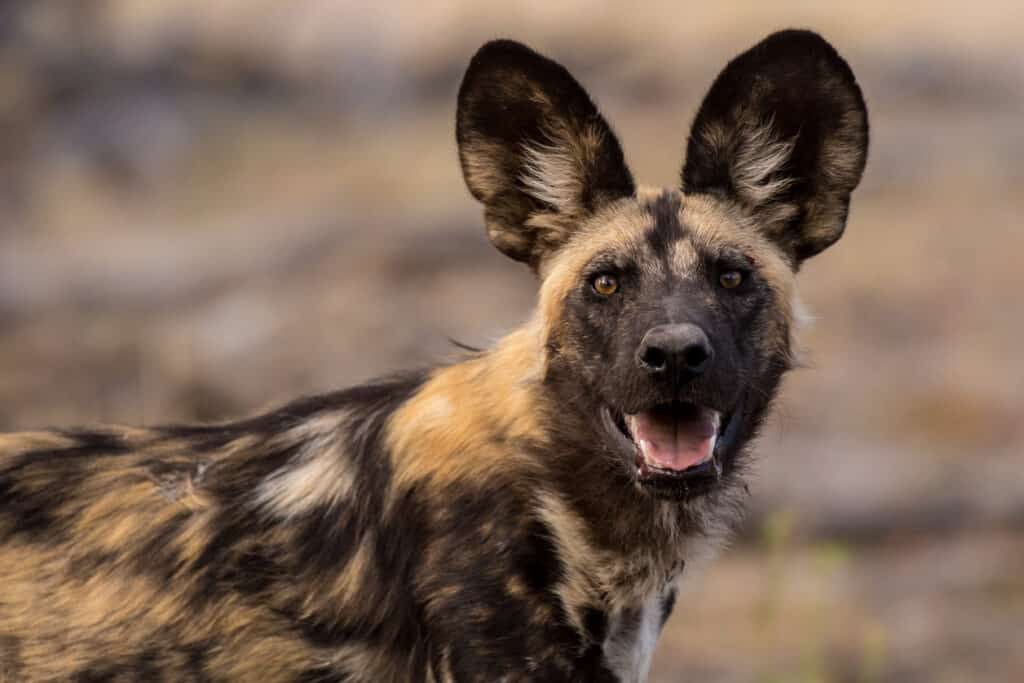The African wild dog is a unique canine. Also known as the painted dog or Cape hunting dog, wild dogs look like no other dogs on earth. Unfortunately, there are not nearly as many of these distinctive animals in the wild as there used to be. Let’s look at the African wild dog’s status on the endangered species list and how soon they may go extinct.
What is an African Wild Dog?

The wild dog’s large ears give them excellent hearing.
©William Steel/Shutterstock.com
Native to sub-Saharan Africa, the African wild dog (Lycaon pictus) is a canine in the Canidae family. While they share the family with dogs, grey wolves, coyotes, and jackals, wild dogs are not a member of the Canis genus like the rest of them. These exclusive animals are the only living species in the Lycaon genus, and their closest shared ancestor with the wolf was over 2 million years ago.
African wild dogs do share something in common with dogs: Speed. These fast animals can run up to 44 miles an hour — the same speed as a domestic greyhound. This speed makes them adept hunters. African wild dogs are carnivores that live in packs of 10-40 animals. Members of the pack live and hunt together. Because of their quick moves and good pack communication, they are the most successful hunters in Africa and have an unrivaled 80% success rate.
A Colorful Canine
While wild dogs are lauded for their hunting and speed, the most distinctive thing about them may be their appearance. African wild dogs have long legs and oversized rounded ears that give them a clownish appearance. Their coat is colorful, with numerous different shades and patterns. They are the fifth-largest canid species (smaller only than four types of wolves) and generally weigh 40-70 pounds. A bushy tail with a white tip helps them communicate while hunting. And each animal is totally unique: No two wild dogs have the same coat patterns.
Where to Find African Wild Dogs
Wild dogs live in arid habitats such as savannahs, grasslands, and open woodlands. While they were once found across most of Africa, populations are now limited to southern Africa, with viable populations in Botswana, Namibia, Kenya, South Africa, Mozambique, Zimbabwe, Zambia, and Tanzania. Packs are nomadic and some have ranges of up to 900 square miles.
Are African Wild Dogs Endangered?

Wild dog packs are nomadic and have ranges that cover up to 900 square miles.
©iStock.com/Ondrej Prosicky
In short, yes. African Wild Dogs are one of the most endangered species on the planet. Wild dogs were listed on the International Union for Conservation of Nature and Natural Resources (IUCN) Red List as an endangered species in 1990. They have remained on the list since then. IUCN reports that there may be as few as 1,400 mature wild dogs left in the wild, with a total estimated population of around 6,600 animals.
Why Are They Endangered?

Pack hunters, wild dogs are highly successful at taking down prey as a group.
©charles Hopkins/Shutterstock.com
African wild dogs suffer from the same threats as many other animals. Loss of habitat and habitat fragmentation has greatly affected wild dog populations. Mining, commercial development, agriculture and ranching, logging, and travel infrastructure have all encroached on wild dog territory. This development has cut wild dogs off from their traditional territories, isolating populations and putting them at higher risk for disease and mortality. It has also increased human-wildlife conflict.
Conflict with humans is another threat to wild dogs. While wild dogs are often not the intended target, they are frequent victims of poaching. They are also sometimes intentionally killed for use in traditional medicine. African wild dogs are also often poisoned by farmers and ranchers who do not want the dogs near their livestock. One study found that 44% of wild dog deaths at the study sites were human-related.
Natural threats have also affected the wild dog population. Diseases like rabies and distemper spread quickly and can knock out smaller isolated populations entirely. These diseases are particularly contagious and transmissible in pack animals that live communally and spend their time in close proximity to one another. Wild dogs also face predation from lions, which see the dogs as competition. Lions often kill wild dogs on sight to protect resources and eliminate perceived rivals.
When Will They Go Extinct?

Wild dogs have distinctive coat patterns and no two are alike.
©Derek Keats / CC BY 2.0, Flickr – License
African wild dogs will disappear from the wild unless action is taken to protect them. In addition to threats from humans, habitat fragmentation, disease, and competition, wild dog populations are vulnerable to climate change. Researchers in Great Britain reported that wild dogs will likely go extinct if global temperatures increase by 5.4°F, which could happen by 2070.
That of course, assumes that wild dog populations will last another 50 years. By mitigating human-wildlife conflicts and protecting habitats, there is a chance that wild dog populations could rebound. The African Wildlife Foundation has several conservation and education initiatives underway to protect this fragile species, but large efforts must be undertaken to preserve the African wild dog.
The photo featured at the top of this post is © Richard Juilliart/Shutterstock.com
